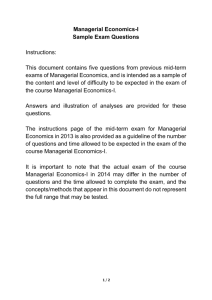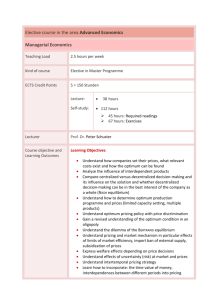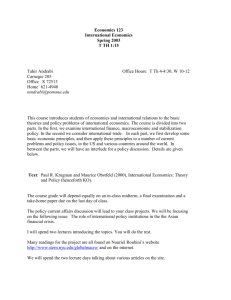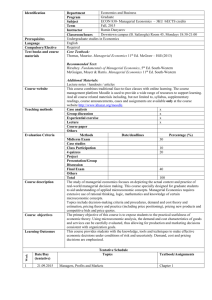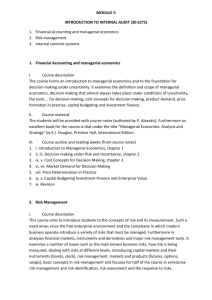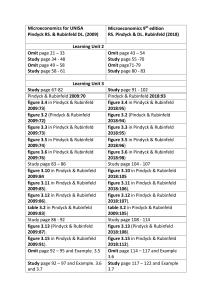EC209 Managerial Economics
advertisement
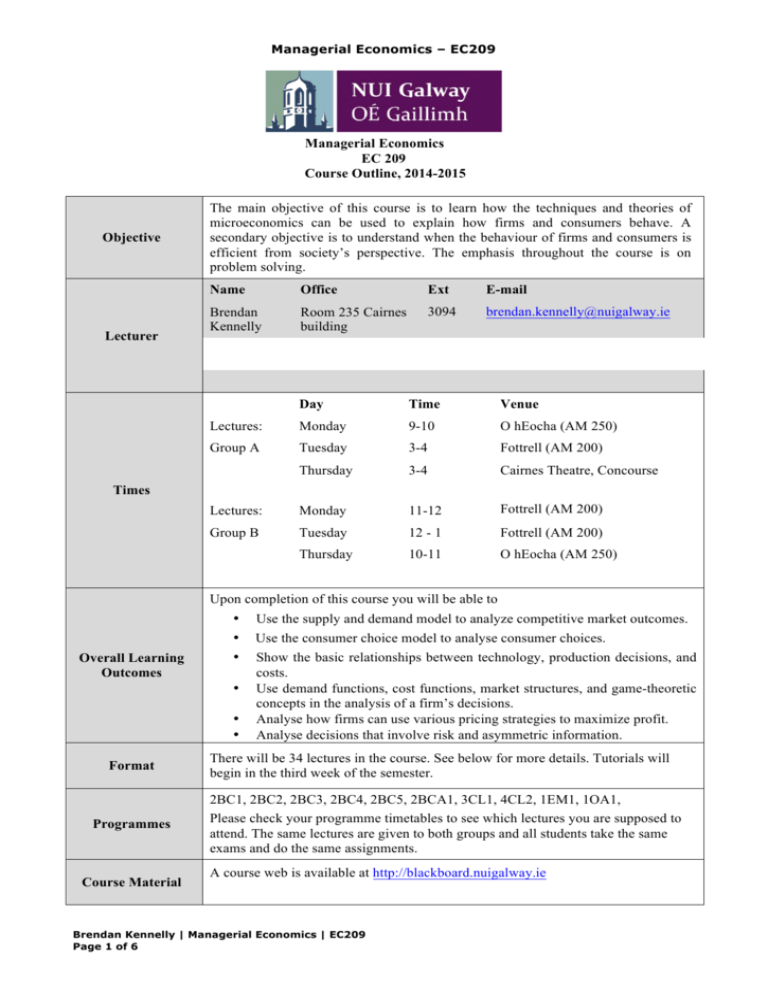
Managerial Economics – EC209 Managerial Economics EC 209 Course Outline, 2014-2015 Objective Lecturer The main objective of this course is to learn how the techniques and theories of microeconomics can be used to explain how firms and consumers behave. A secondary objective is to understand when the behaviour of firms and consumers is efficient from society’s perspective. The emphasis throughout the course is on problem solving. Name Office Ext E-mail Brendan Kennelly Room 235 Cairnes building 3094 brendan.kennelly@nuigalway.ie Day Time Venue Lectures: Monday 9-10 O hEocha (AM 250) Group A Tuesday 3-4 Fottrell (AM 200) Thursday 3-4 Cairnes Theatre, Concourse Lectures: Monday 11-12 Fottrell (AM 200) Group B Tuesday 12 - 1 Fottrell (AM 200) Thursday 10-11 O hEocha (AM 250) Times Upon completion of this course you will be able to Overall Learning Outcomes • Use the supply and demand model to analyze competitive market outcomes. • Use the consumer choice model to analyse consumer choices. • Show the basic relationships between technology, production decisions, and costs. Use demand functions, cost functions, market structures, and game-theoretic concepts in the analysis of a firm’s decisions. Analyse how firms can use various pricing strategies to maximize profit. Analyse decisions that involve risk and asymmetric information. • • • Format Programmes Course Material There will be 34 lectures in the course. See below for more details. Tutorials will begin in the third week of the semester. 2BC1, 2BC2, 2BC3, 2BC4, 2BC5, 2BCA1, 3CL1, 4CL2, 1EM1, 1OA1, Please check your programme timetables to see which lectures you are supposed to attend. The same lectures are given to both groups and all students take the same exams and do the same assignments. A course web is available at http://blackboard.nuigalway.ie Brendan Kennelly | Managerial Economics | EC209 Page 1 of 6 Managerial Economics – EC209 Core Text Microeconomics, 8th edition, by Robert Pindyck and Daniel Rubinfeld (Pearson, 2012). You should purchase a copy of this book. You may be able to buy a second hand copy of the 6th or 7th editions of the book and they are perfectly acceptable substitutes. A few additional readings will be placed on the course blackboard. The new edition is accompanied by a subscription to MyEconLab but we will not be using this feature for the course. 1. End of Year Examination 50% or 75% 2. Midterm Examination 25% or zero 3. Continuous Assessment 25% Continuous assessment involves 8 assignments. Your overall assignment score will be based on the best 7 assignments that you complete. Assessment The midterm examination will be held at 7.00 p.m. on Monday, October 13. All students are required to take the midterm examination. The final examination will consist of two parts. The first part will examine material that will be examined in the midterm examination. The second part will examine the material taught in the second half of the course. All students must answer the second part of the final examination. If a student is happy with the mark he or she received on the midterm exam he or she can decide not to answer the first part of the final examination. In that case the final exam will count for 50% of the overall grade and the midterm will count for 25% of the overall grade. If you do both parts of the final exam and your mark on the first part is better than your mark on the midterm I will not count your midterm exam in calculating your overall grade. In that case your final exam will count for 75% of your overall grade. You do not have to inform me beforehand whether you are planning to answer the first part of the final exam or not. If for any reason you do not take the midterm examination then your final exam will count for 75% of your overall grade. Note that the final exam is 2 hours long for all students regardless of whether they are attempting the first part of the exam or not. You must get 35% in the written examination part of the module in order for your continuous assessment to be counted. Credit weighting: Workload hours Office hours 5 ECTS Lecture hours: 35 Tutorial hours: 10 Independent assignment work: 20 Independent study: 61 Total Student Effort: 125 Monday: 3.00 – 5.00; Tuesday: 4.15 - 6.00; or by appointment. In addition to office hours I will be available on a regular basis to answer questions on a web site called BlikBook that is very useful. To register for BlikBook please go to the following link: www.blikbook.com/accounts/register/EC209 Brendan Kennelly | Managerial Economics | EC209 Page 2 of 6 Managerial Economics – EC209 Outline: Topic Week 1: Course outline and structure; Fundamentals of managerial economics; Supply and Demand Readings Pindyck & Rubinfeld, Chapters 1 & 2 Section Outcomes: You will be able to … • • • • • • • Define managerial economics Locate managerial economics within your broader study of economics Relate managerial economics to the broader study of management Recognise how the topics in this course are linked to each other State six key ideas in managerial economics which you will use many times in this course Explain how demand and supply describe the intentions of consumers and firms Use demand and supply analysis to work out equilibrium price and quantity in a market Week 2: Supply and Demand; Elasticity Pindyck & Rubinfeld, Chapter 2 Section Outcomes: You will be able to … • • • • • • • Relate demand and supply as represented by functions to demand and supply as represented by diagrams Use demand and supply analysis to work out the effects of restrictions on market prices Use demand and supply analysis to work out changes in equilibrium price and quantity in a market Use various elasticities of demand to forecast changes in revenues, prices, and/or units sold Illustrate the relationship between elasticity and marginal and total revenue Discuss the factors that determine whether a good is likely to have an elastic or inelastic demand Show how to use elasticities to estimate linear demand and supply functions Week 3: Consumer Choice Theory Pindyck & Rubinfeld, Chapter 3 Section Outcomes: You will be able to … • • • Relate the graphical device of indifference curves to the underlying concept of rational preferences Use the budget constraint to graphically illustrate the concept of limited resources Derive equilibrium, and analyse changes in equilibrium for a rational individual Week 4: Applications of Consumer Choice Theory Pindyck & Rubinfeld, Chapter 4 Section Outcomes: You will be able to … • • • Apply the consumer choice model to a variety of choice situations Decompose the impact of a price change into income and substitution effects Use the tools of rational choice analysis to derive the demand curve Week 5: Choice under uncertainty; Behavioural Economics; Brendan Kennelly | Managerial Economics | EC209 Page 3 of 6 Pindyck & Rubinfeld, Chapter 5; Managerial Economics – EC209 Online readings Section Outcomes: You will be able to … • • Identify strategies to manage risk and uncertainty Explain the main features of behavioural economics Week 6 (Midterm week): Production; Pindyck & Rubinfeld, Chapter 6; Section Outcomes: You will be able to … • Recognise the production function as relating inputs to outputs, and distinguish between different measures of productivity Week 7: Costs; Perfect Competition; Pindyck & Rubinfeld, Chapters 6 & 7 Section Outcomes: You will be able to … • • • Relate the cost structure of the firm to both the production function and cost-minimising behaviour Use isoquant/isocost analysis to illustrate optimal input substitution Distinguish between different types of cost which you derive from a cost function, such as total, average and marginal Week 8: (no lecture on October 27th): Perfect Competition; Analysis of competitive markets Pindyck & Rubinfeld, Chapter 8 Section Outcomes: You will be able to … • • • Distinguish the market structure of perfect competition in terms of its key assumptions Apply the profit-maximisation rule to determine price and quantity outcomes for firms in this market structure Explain how firms in perfect competition adjust in the short and long run to exogenous changes Week 9: Analysis of competitive markets; Monopoly and monopolistic competition Brendan Kennelly | Managerial Economics | EC209 Page 4 of 6 Pindyck & Rubinfeld, Chapters 9 & 10 Managerial Economics – EC209 Section Outcomes: You will be able to … • • • • • • Analyse the efficiency properties of this market structure Analyse various interventions in competitive markets Distinguish these market structure in terms of their key assumptions Apply the profit-maximisation rule to determine price and quantity outcomes for firms in these market structures Explain how firms in monopolistic competition and monopoly adjust in the short and long run to exogenous changes Analyse the efficiency properties of these market structures Show the relationship between the elasticity of a firm’s product and its marginal revenue Week 10: Pricing Strategies Pindyck & Rubinfeld, Chapter 11 Section Outcomes: You will be able to … • • • Identify a range of pricing strategies open to firms in different environments Apply the profit-maximisation rule in order to arrive at the appropriate pricing strategy, given the particular market structure the firm faces Explain the conditions under which different pricing strategies such as price discrimination, twopart pricing, peak-load pricing, and block pricing yield higher profits than standard pricing Week 11: Oligopoly Pindyck & Rubinfeld, Chapter 12 Section Outcomes: You will be able to … • • • Distinguish between models of oligopoly and other models of market structure in terms of the emphasis in oligopoly on strategic interactions between firms Set out the distinctive assumptions of three types of oligopoly models, namely those of (a) Cournot, (b) Stackelberg and (c) Bertrand oligopoly Derive and apply the tool of reaction functions to arrive at equilibrium in each of these models and therefore to compare market outcomes between them. Weeks 12: Game Theory Pindyck & Rubinfeld, Chapter 13 Section Outcomes: You will be able to … • • • Distinguish between the major types of games as models of strategic interaction Represent the assumptions of a range of strategic interactions in oligopolistic settings, such as pricing decisions, advertising, collusion and product quality in an appropriate game-theory form (e.g., one-shot or repeated games, whether finite or finite, simultaneous move or multi-stage games, as applicable) Use the appropriate solution concept and method in each oligopolistic situation to arrive at the range of equilibria outcomes or strategies that may result Brendan Kennelly | Managerial Economics | EC209 Page 5 of 6 Managerial Economics – EC209 Tutorial and Assignment Schedule Chapter in textbook 2 Tutorials Topic September 23 and 24 3 4 September 30 and October 1 October 7 and 8 Supply, demand, elasticity Consumer Behaviour 2, 3, 4 and 5 6 7 8 and 9 October 14 and 15 October 21 and 22 October 28 and 29 November 4 and 5 10 11 12 13 November 11 and 12 November 18 and 19 November 25 and 26 None Individual and Market Demand Midterm review Production Costs Perfect Competition; Competitive Analysis Monopoly Pricing strategies Oligopoly Game Theory Assignment due September 27 October 4 October 11 None None November 1 November 8 None November 22 November 29 November 30 Beginning in week 3 students will complete weekly assignments on Blackboard. The assignments will typically consist of 6 multiple choice questions. These will be randomly assigned to each student from a large pool of questions. The questions are mainly problem type questions and many of them are based on questions at the end of each chapter in the textbook. Some of the questions have appeared on exams in this subject over the last nine years. Students have two opportunities to do each assignment. Note that because the questions are randomly assigned from a pool it is unlikely that a student will have to do exactly the same questions on two attempts at a particular assignment. The deadline for each assignment will be 11.00 p.m. on Saturday of each week (except for the last assignment which will be due on a Sunday). You will be able to find out your mark on each assignment once you have submitted it but bear in mind you only have two attempts at each test. Once the deadline for a particular test has passed I will post a new ungraded test with all of the questions in each pool of questions. These ungraded tests will include solutions to most of the questions in each pool. The tutorials will be held on Tuesday and Wednesday of each week. The questions worked on in tutorials will be posted on Blackboard before the tutorials. Many of the questions worked on in tutorials have appeared on previous exams. Solutions to tutorial questions will be posted on Blackboard after the tutorials for the corresponding week have been held. The biggest difference between the tutorial questions and assignment questions is that the latter includes only multiple choice questions while the tutorial questions are generally open answer questions. However the content of the questions is often very similar. Most of the questions on the exams are open ended problem type questions. We will be using a service called BlikBook to post and answer questions about the course. To register for BlikBook please go to the following link: www.blikbook.com/accounts/register/EC209 Brendan Kennelly | Managerial Economics | EC209 Page 6 of 6

